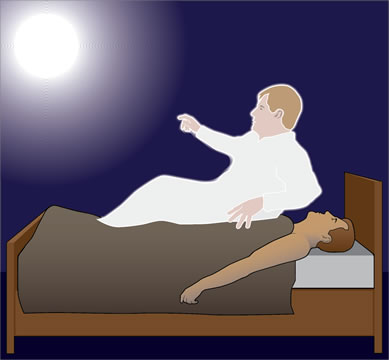 They generally know that if they cross the barrier they
may not go back to their life. The patient reports being told it is
"not their time", or they choose to go back to fulfill
a life purpose.
They generally know that if they cross the barrier they
may not go back to their life. The patient reports being told it is
"not their time", or they choose to go back to fulfill
a life purpose. Approximately 10% of all severely injured patients have a near-death experience (NDE). There are certain components of NDEs that are classic, but experiences do vary. Typically, the patient is aware that something very serious has happened to them and they may fear that death is imminent. After this, most report feeling total love and peace. This peaceful feeling is often extraordinary and incomparable to any the individual has felt before.
While it is common for the NDE to include a feeling of peace, some people report watching a procedure, such as their resuscitation. Unlike an out of body experience (OBE), this individual is not concerned with his body. Some have said that they did not even recognize it as a body, but as " a grocery sack" they once traveled in. When asked how they looked, since their body is perceived to be elsewhere, they often do not remember. Some will say they have a form similar to the shape of the body or that they are made up of light.
At this point the patient's vision is generally normal, but their hearing is telepathic. They generally report knowing information automatically rather than hearing it.
In the more extreme experiences, the patient will continue the experience and often go through a tunnel of some sort. Dead friends and relatives are commonly seen and they may see a light or a figure they believe represents God. Often at this point the patient sees a barrier of some sort: a wall, hedge, gate, river, meadow, or mountain.
 They generally know that if they cross the barrier they
may not go back to their life. The patient reports being told it is
"not their time", or they choose to go back to fulfill
a life purpose.
They generally know that if they cross the barrier they
may not go back to their life. The patient reports being told it is
"not their time", or they choose to go back to fulfill
a life purpose.
While the above seems very positive and tranquil, there are also negative NDE experiences reported. Greyson and Bush (1992) classify distressing near-death experiences into three distinct types: those perceived as frightening, the second type is an experience of nothingness or being in a void and third type consistent with the popular concept of hell. These persons may report "going down" and seeing hellish figures. Afterwards, some patients feel obligated to tell people that "hell exists." Others have no idea why they were there.
Research has not revealed a direct correlation between the type of life style and the type of NDE a person may experience. As far as we know, negative NDEs simply happen. These negative experiences are much more rare than the comparably positive ones.
A near-death experience is always transforming. Afterwards, patients are often much more caring and altruistic, and much less materialistic and self-serving. Another aftermath of these experiences for some people is that they report an increase in psychic ability and claim they cause interference with electronic equipment.
 The experience remains vivid with these
individuals for years. They often report losing their fear of
death, and having a renewed interest in living and fulfilling
their purpose.
The experience remains vivid with these
individuals for years. They often report losing their fear of
death, and having a renewed interest in living and fulfilling
their purpose.
Do these patients really go out of their bodies? Certainly their perception is that part of their consciousness - the part they say is really "who they are" - goes on without their body. Many anecdotal reports from subjects stimulate research questions because these experiences cannot be easily explained. For example, in one case, a patient reported having a near-death experience while she was resuscitated. She told a nurse she saw a red shoe on the roof of the hospital. The nurse told a resident, who in turn had someone unlock the door to the roof. He descended from the roof with a red shoe in hand. Research is being conducted to try to establish the validity of what these subjects see during the NDE.
Instant Feedback:
©RnCeus.com